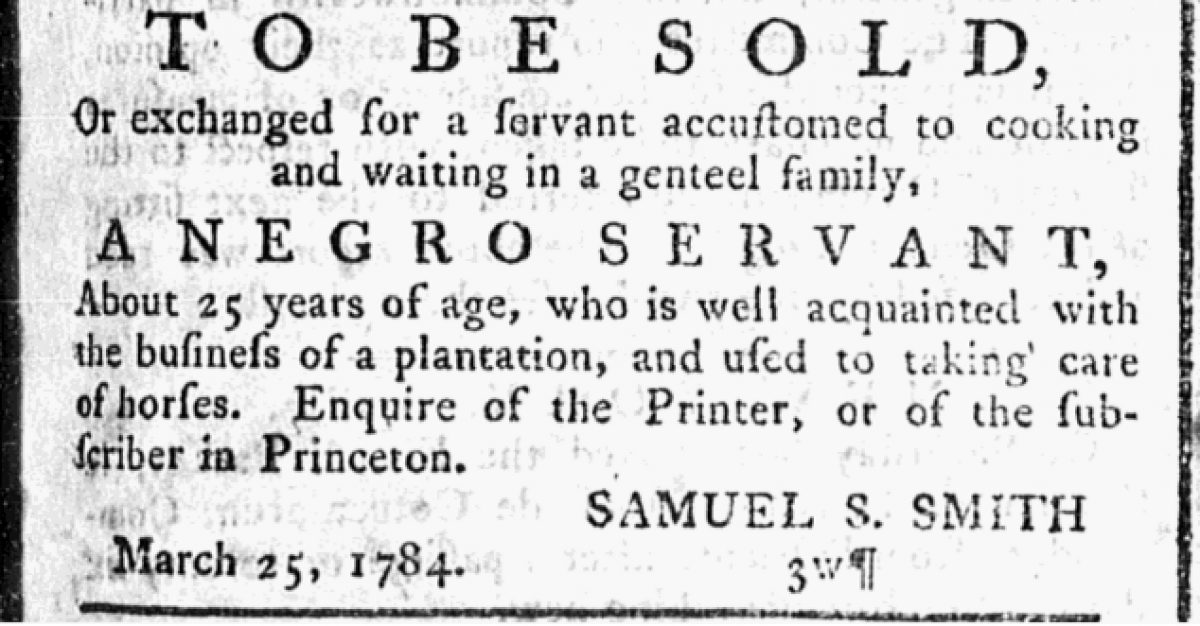Introduction
Aaron Burr Sr. moved into his new home in Princeton some time in December of 1756.[1] The second president of the College of New Jersey, Burr had been holding classes at his parsonage in Newark since 1748—but at last, after years of fundraising and construction, the college had a proper seat in Nassau Hall. And as students began to fill the dormitories (plasterers and carpenters still putting the finishing touches on the new college building), Burr, his wife Esther, and their two children Sarah and Aaron Jr., took up occupancy in the brick house the college trustees had ordered built alongside Nassau Hall.[2]
Today we call that building the Maclean House in honor of John Maclean Jr., Princeton’s tenth president and founder of the Alumni Association (whose offices now occupy the building). In 1756, however, it was simply the “President’s House”—a comfortable three-story residence in Nassau Hall’s imposing shadow. “Its relation to Nassau Hall—forward of it and to the side—brings to mind the servants’ wing of a great southern mansion,” art professor and Princeton alumnus Paul Norton wrote in 1956, the year of the campus bicentennial. “For was not the president the faithful servant of the college?”[3]
Norton’s comparison of the campus to an antebellum plantation may have been more appropriate than he knew. Between the college’s founding in 1746 and the end of the Civil War in 1865, at least 40% of Princeton alumni came to New Jersey from Southern slave-holding states—with Southerners regularly the majority of students in their graduating classes.[4] Though the myth that students brought enslaved people to Princeton to serve them during their college years is just that—a myth—and the college as an institution never owned slaves, students encountered enslaved men and women in the state of New Jersey, the town of Princeton, and on the campus itself. Princeton’s first nine presidents personally owned slaves at some point in their lives; eight of these men lived at the President's House; and beginning with Aaron Burr Sr. in 1756, at least five of them brought bondspeople with them to President’s House. “Faithful servants of the college” perhaps, these early Princeton presidents were in turn served by others who had no choice in the matter. For the enslaved people who lived, worked, and on one occasion were auctioned off there, the house in the shadow of Nassau Hall was more than a symbolic “servant’s wing” to the college: it contained their actual slave quarters.

View of the College of New Jersey in 1764, with the President's House in the foreground to the right of Nassau Hall.
View Primary Sources
Constructed contemporaneously with Nassau Hall, the President’s House appears in the earliest illustrations of the College of New Jersey. In an engraving from 1764, the house occupies the foreground—its façade, along with Nassau Hall’s, the face of the young college. Though the enslaved people who worked in the President’s House do not figure among the elegantly dressed men and women depicted strolling the grounds, theirs may in fact have been the first faces students saw when they arrived on campus. In the college’s early years, incoming students were required to take an examination with the president before enrolling. And as Martha Sandweiss and Craig Hollander write in their overview of the Princeton and Slavery Project’s findings:
For generations of Princeton students, then, the first person they met on campus may have been the enslaved man or woman who answered their knock on the President’s front door. Quite literally, if Nassau Hall provided the storied backdrop of Princeton University, slavery was the face of the school.[5]
The names and stories of some of the enslaved people at the President’s House are preserved in the historical record—Aaron Burr Sr.’s “Negro Man” Caesar, for example, and Betsey Stockton, an African American woman who would become a prominent figure both in Princeton and internationally.[6] Others, like the six men, women, and children sold at the President’s House in 1766, remain nameless.[7] While they lived, however, they were a visible presence on campus from the time of the college’s founding. And the President’s House—at the left hand of Nassau Hall, temporary seat of the Continental Congress and site of a Revolutionary War battle—was the center of slavery at Princeton.
The House and Its Occupants
Ten of the College of New Jersey’s presidents made the President’s House their home during their terms, beginning with Aaron Burr Sr. in 1756 and ending with James McCosh in 1878.[8] During this period, at least five presidents owned slaves who lived and worked in the house: Aaron Burr Sr., Jonathan Edwards, Samuel Finley, Samuel Stanhope Smith, and Ashbel Green. Three others—Samuel Davies, John Witherspoon, and James Carnahan—also owned slaves during their lifetimes, but it is uncertain whether any of these enslaved people joined their households in Princeton during their presidencies. John Maclean Jr. (president from 1854-1868) was the first non-slaveholder to hold the office of president.
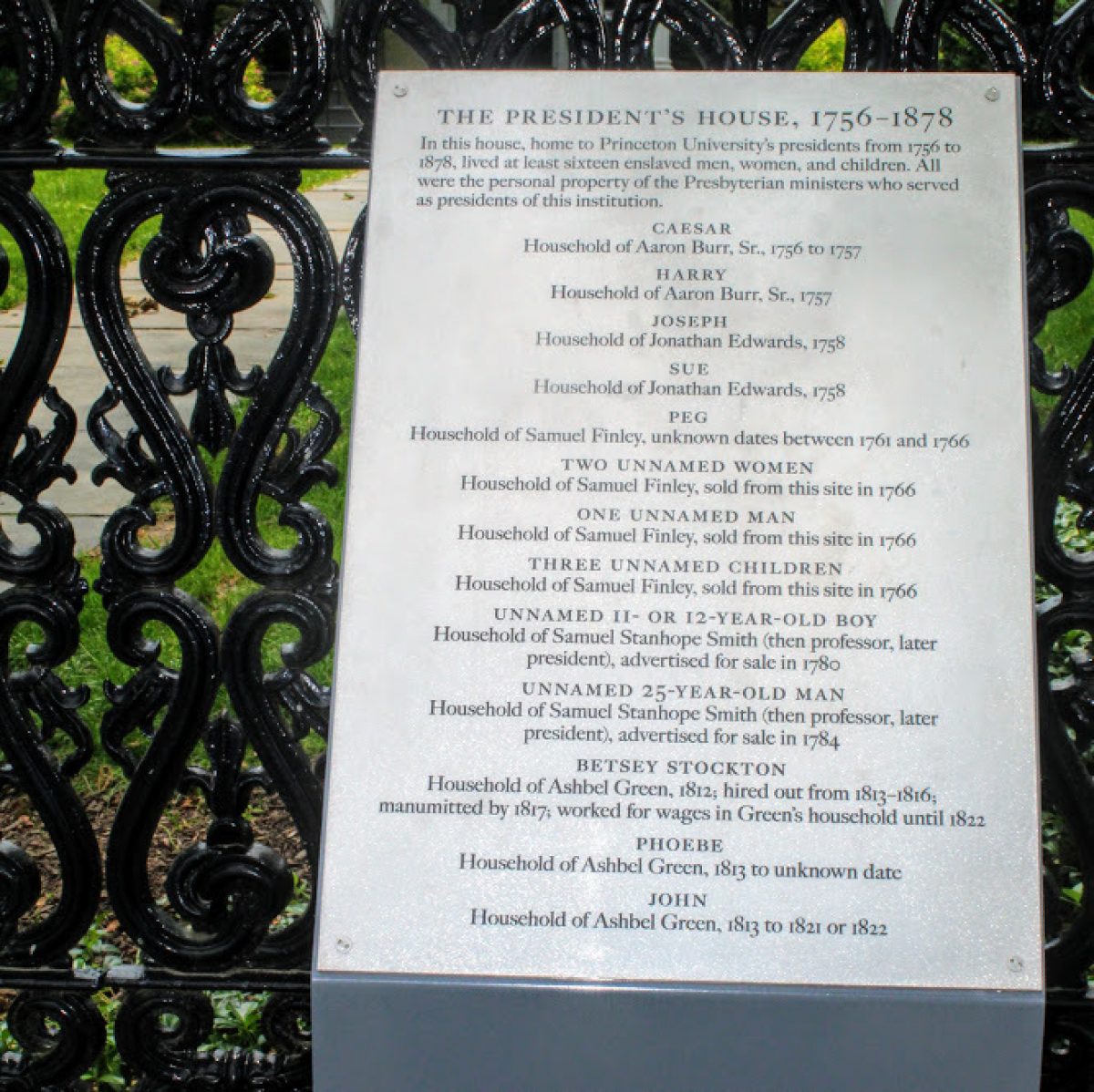
In May 2019, Princeton University placed a memorial plaque commemorating the 16 enslaved people who lived and worked on campus on permanent display outside the historic President's House.
View Primary Sources
Aaron Burr Sr., Caesar, and Harry
Along with his wife and children, Aaron Burr Sr. (president from 1756-1757) likely traveled to Princeton with Caesar, a “Negro Man” Burr had purchased the year before for eighty pounds.[9] Caesar would have been the first person to occupy the slave quarters at the President’s House: a bedroom on the second floor of the detached “Kitchen House” to the rear of the main residence.[10] His work included cooking for the president, his family, and their guests—a laborious process in the colonial-era kitchen, where Caesar prepared meals over an open fire in the large, first-floor fireplace.[11] Persistent campus legend holds that Burr added a covered passageway between the kitchen and house shortly after he moved in so that Caesar could carry food to the dining room in the main residence “without severe cooling of man or meal,” but no contemporary sources have yet been found to verify the story.[12]
After Aaron Burr Sr.’s death in 1757, Sarah Pierpont Edwards (his mother-in-law, and wife of Burr’s successor Jonathan Edwards) expressed interest in purchasing an enslaved man named Harry, who had belonged to Burr.[13] Because Burr died in Princeton, the timing of Sarah’s inquiry indicates that Harry would have worked alongside Caesar in the President’s House.
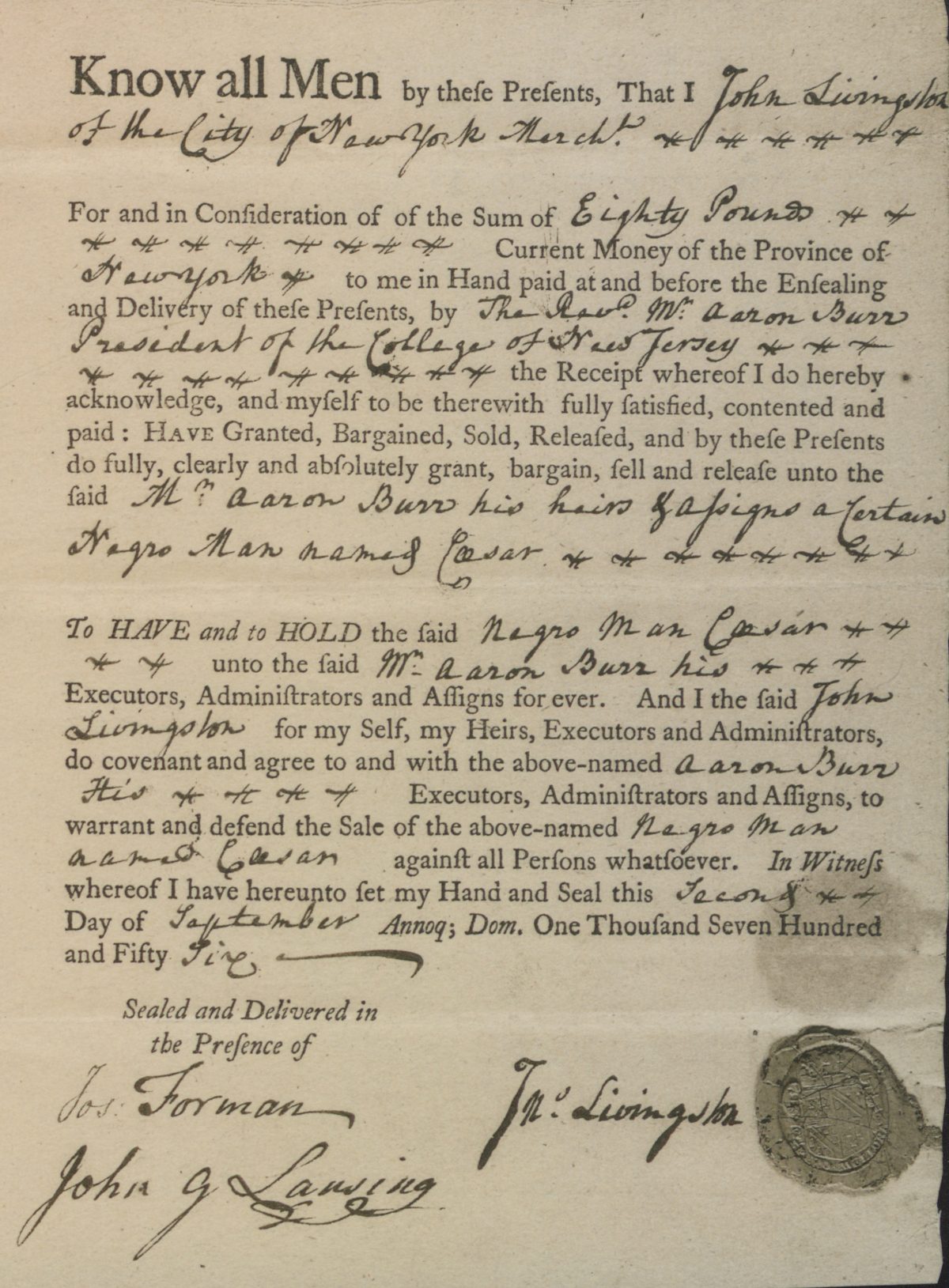
Bill of sale for an enslaved man named Caesar, whom Princeton president Aaron Burr Sr. purchased in 1756.
View Primary Sources
Jonathan Edwards, Joseph, and Sue
Jonathan Edwards (president in 1758) and his wife Sarah owned several slaves throughout their lives, though it is unknown how many of them made the move to Princeton with the Edwards family in 1758.[14] Sarah Edwards inherited an enslaved couple, Joseph and Sue, from her husband after his sudden death in March 1758; they were recorded among Sarah’s property when she died six months later.[15] Joseph and Sue may have been a part of Edwards's Princeton household during his short term as president.
The two would have performed similar work to Caesar and Harry—cooking in the Kitchen House, heating and hauling water to the main residence, cleaning, and maintaining the grounds. Sue may have had additional duties conventionally performed by women in the 18th century. In 1746, Jonathan Edwards wrote a colleague that “my wife desires that the person you procure … to be her maid, be one that is a good hand at spinning fine linen.”[16] Perhaps Sue was the answer to Sarah’s inquiry, serving as a personal maid to the president’s wife and assisting her with sewing and spinning.
Samuel Finley, Peg, and the Estate Sale
At least seven enslaved people served Samuel Finley (president from 1761-1766) during his tenure at Princeton. One, “a negro girl, Peg” appears in Finley’s will; Peg was bequeathed to his daughter Rebecca Breese, who lived with her husband in Newark.[17] Finley’s will directed his executors to sell the rest of his personal property and divide the proceeds among his widow and other children—and that property included his six remaining slaves. On July 31, 1766, two weeks after Finley’s death, the Pennsylvania Journal announced that his possessions would be auctioned off the following month. The newspaper advertised the contents of Finley’s estate: “two negro women, a negro man, and three Negro children” to be sold alongside horses, cattle, farming tools, furniture, and the college president’s personal library.[18]
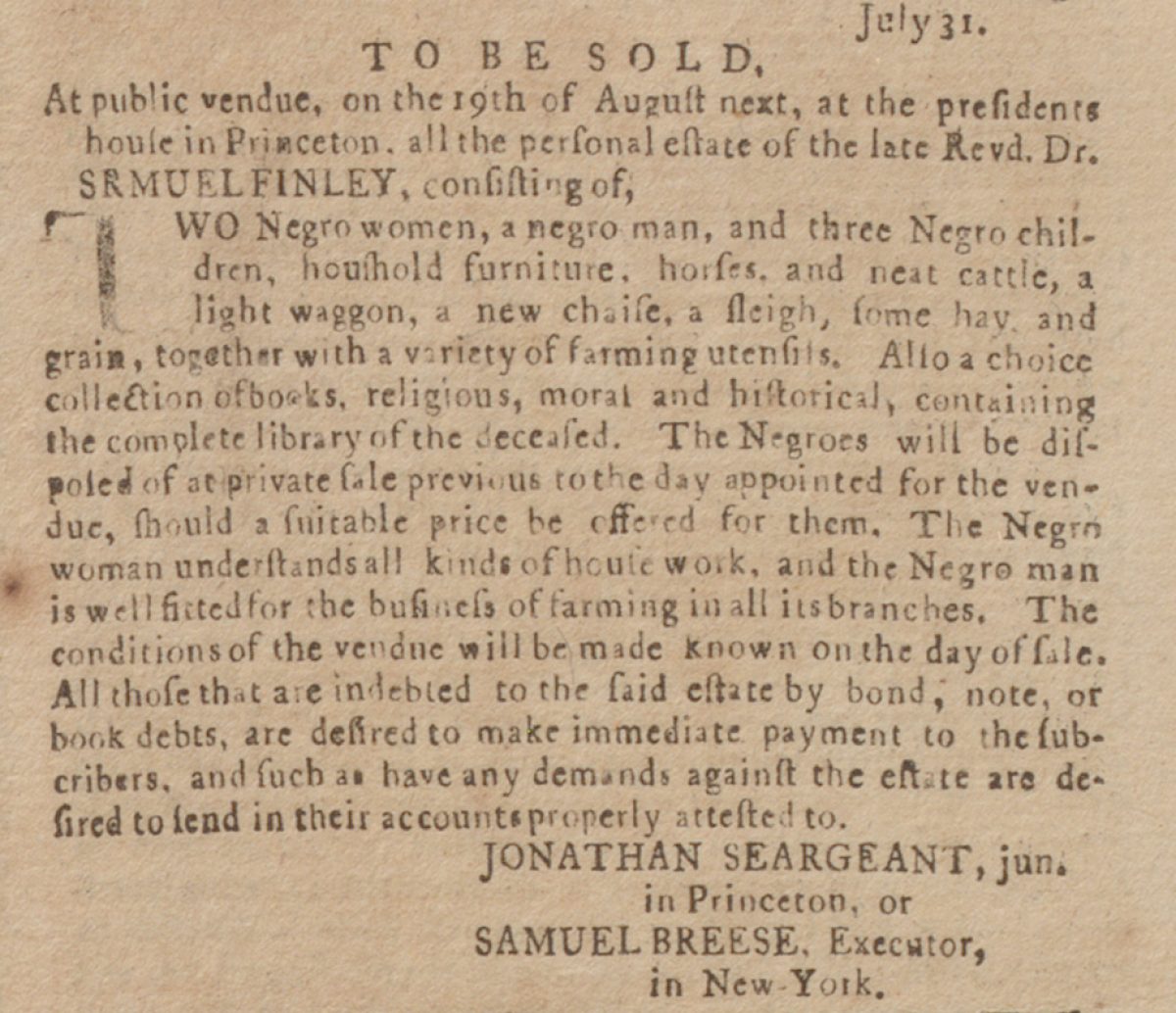
An advertisement announcing the estate sale of President Samuel Finley, held at the President's House on campus.
View Primary Sources
The auction took place on August 19th, at the President’s House itself—a location that combined tragedy with irony.[19] Just one year prior, in September 1765, the college trustees had voted to purchase and plant two “button-wood” (sycamore) trees outside the President’s House in order to improve the campus landscape.[20] Today the twin sycamores—still standing after more than two hundred years—are commonly known as the “Stamp Act trees” or “liberty trees,” with campus myths (and generations of tour guides) claiming that the trees were planted to commemorate the repeal of the unpopular Stamp Act in 1766.[21] (Though as one alumnus wrote as early as 1914, because the purchase was authorized before the repeal, “unless one ascribe to the trustees the gift of prophecy the claim can have no justification.”)[22]
Although factually inaccurate, the popular association of the trees with the repeal of the Stamp Act has served to make them symbols of Princeton’s commitment to Revolutionary principles.[23] Just months after the Stamp Act was repealed, however, the so-called “liberty trees” outside the President’s House provided the backdrop for a slave auction—underlining the interconnection of liberty and slavery in Princeton’s history.

A photograph of the President's House, with Nassau Hall in the background and the "liberty trees" in the foreground.
View Primary Sources
Samuel Stanhope Smith, “A Likely Negro Boy,” and “A Negro Servant”
Samuel Stanhope Smith (president from 1795-1812) moved into the President’s House with his family during his father-in-law John Witherspoon’s term. Witherspoon, who served as president from 1768 to 1794, occupied the house only until 1779, when he relocated to his 500-acre country home outside of town; his son-in-law Smith moved into the empty house that year when he joined the college faculty. Smith, Professor of Moral Philosophy, owned at least two enslaved people during his long residence in the President’s House—both of whom he advertised for sale in the 1780s.

Newspaper advertisement for a slave sale by Professor Samuel Stanhope Smith in 1780.
View Primary Sources
In November 1780, the New Jersey Gazette ran a notice announcing the sale of “a likely negro boy, between eleven and twelve years of old.”[24] Smith placed the ad just months after an enslaved man named Michael Hoy ran away from the neighboring Prospect estate; to aid in his escape, Hoy and a white accomplice stole one of Smith’s horses.[25] Smith offered a $600 reward for his horse’s return and Hoy’s capture, but Hoy seems not to have been caught.[26] The timing begs a disturbing question: did Smith wish to sell the eleven-year-old “negro boy” later that year in order to recoup the monetary value of his stolen mare?
Four years later, in March 1784, Smith placed another notice for the sale of “a negro servant, about 25 years of age.”[27] The professor’s description of the enslaved man—"well acquainted with the business of a plantation, and used to taking care of horses"—identifies the work he had performed for Smith. By 1784, however, the Princeton professor decided he no longer needed a groom and agricultural laborer. Instead, he advertised his desire to sell or exchange this "negro servant" for "a servant accustomed to cooking and waiting in a genteel family."
It is unknown when or if either of these individuals were sold, or whether Smith owned other enslaved people after 1795, when he became president of the college.
Ashbel Green, Betsey Stockton, John, and Phoebe
Ashbel Green (president from 1812-1822) succeeded Smith as president after Smith’s forced resignation in 1812. Green regularly wrote in a private diary, describing his religious devotions, duties and struggles as president, and household management—including, on multiple occasions, details of his interactions with three enslaved people at the President’s House.
In June 1813, eight months after moving to Princeton, Green wrote in his diary that he had “purchased the time of a black boy and black girl” from the executors of a recently deceased woman’s estate.[28] The boy, John, was twelve years old at the time, and the girl, Phoebe, was nearly eighteen. Green made an informal agreement with the two young people that he would free them each at the age of twenty-five; he further noted that “I told them both that if they served me to my entire satisfaction and that of my wife, I would give to each of them a year of their time. Otherwise I would not give them any.”[29] Phoebe most likely cooked, performed housework, and helped care for Green’s infant son Ashbel. By age twenty, John was regularly driving the president and his sons in their carriage. Phoebe is not mentioned again in Green’s diary after 1813, so it is uncertain when or if Green freed her. John appears in the diary until at least 1821.
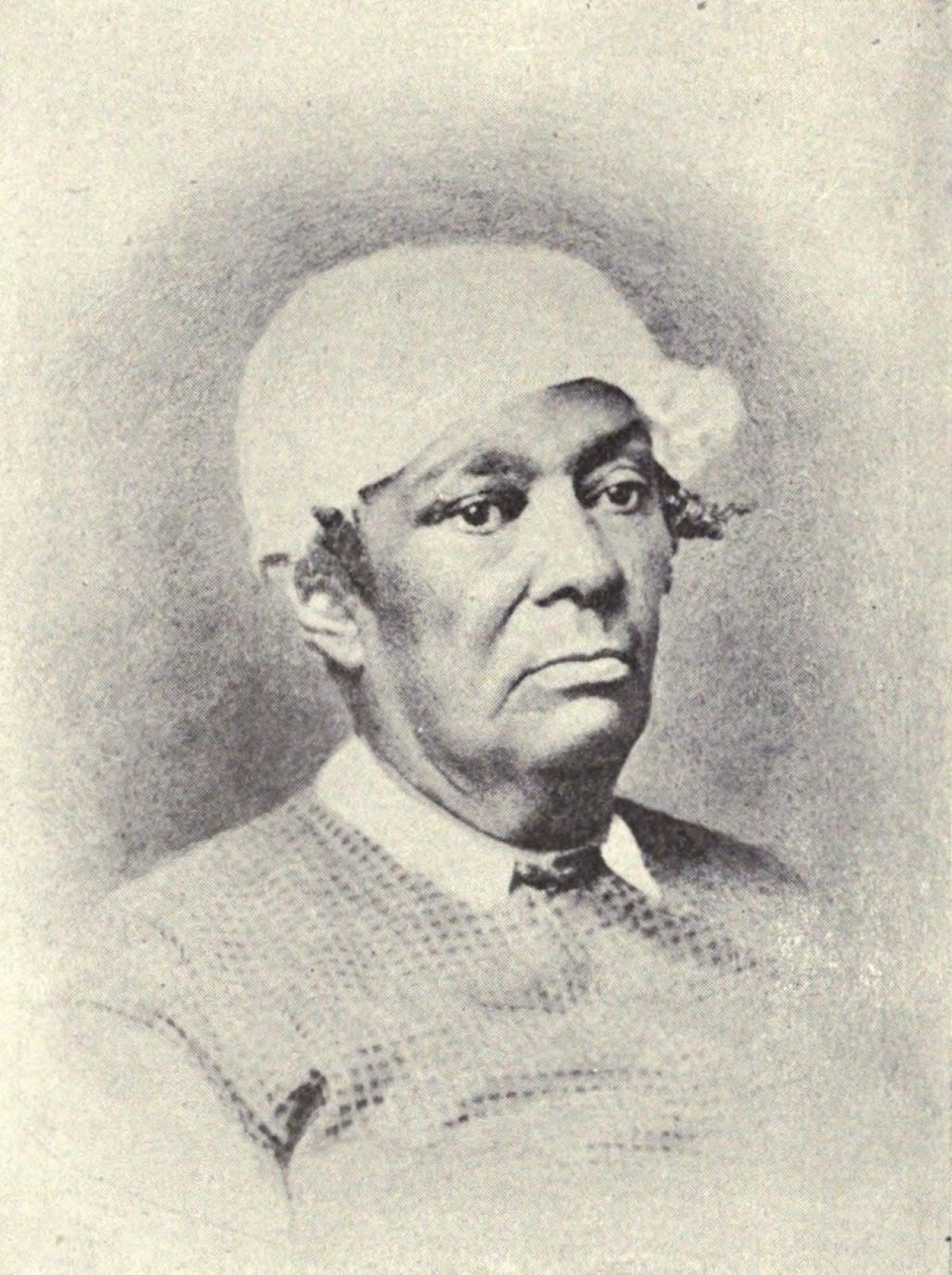
Photograph of Betsey Stockton, a former slave who served as a missionary and teacher in the Sandwich Islands (present-day Hawaii).
View Primary Sources
Betsey Stockton, an enslaved women given as a gift to Green’s first wife, joined John and Phoebe at the President’s House in 1817.[30] In 1813, Green had sold three years of Betsey’s time to his nephew, but she returned to Princeton after the death of Green’s third wife in 1817 and was emancipated at that time. Betsey worked for wages at the President’s House until 1822, when Green resigned the presidency and Betsey embarked on a missionary trip to the Sandwich Islands (present-day Hawaii). Betsey Stockton, the country’s first unmarried female missionary abroad, worked as a teacher on the Sandwich Islands—a vocation she continued when she returned to the United States, establishing schools for African American children in Philadelphia as well as Princeton.
About the Author
R. Isabela Morales is an award-winning author and public historian. Her first book, Happy Dreams of Liberty: An American Family in Slavery and Freedom, received the 2023 Frederick Douglass Book Prize, the 2023 Tom Watson Brown Book Award, the 2023 Shapiro Book Prize, the 2023 William Nelson Cromwell Book Prize, the 2024 James F. Sulzby Book Award, and was a finalist for the prestigious Harriet Tubman Prize. Dr. Morales received her Ph.D. in history from Princeton University in 2019. She has been involved in the Princeton & Slavery Project since its founding as a researcher, contributing writer, editor, and project manager.
View all stories by R. Isabela Morales »
Bibliography
The author is grateful to Francesca Saldan, former Princeton University Art Museum intern, for her research assistance.
References
[1]
Charles E. Peterson, Constance M. Greiff and Maria M. Thomspon, Robert Smith: Architect, Builder, Patriot, 1722-1777 (Philadephia: The Athenaeum of Philadelphia, 2000), 52.
⤴
[2]
Thomas Jefferson Wertenbaker, Princeton, 1746-1896 (Princeton, NJ: Princeton University Press, [1946] 1996), 40; Minutes; 25 September 1754; Board of Trustees Records, Princeton University Archives, Department of Rare Books and Special Collections, Princeton University Library.
⤴
[3]
Paul Norton, “Robert Smith’s Nassau Hall and President’s House,” in Nassau Hall, 1756-1956, ed. Henry Lyttleton Savage (Princeton, 1956).
⤴
[4]
Joseph Yannielli, “Princeton’s Fugitive Slaves,” accessed 7 July 2017, Princeton & Slavery Project, accessed 27 September 2017, slavery.princeton.edu/stories/runaways.
⤴
[5]
Craig B. Hollander and Martha A. Sandweiss, “Princeton and Slavery: Holding the Center,” Princeton & Slavery Project, accessed 27 September 2017, slavery.princeton.edu/stories/princeton-and-slavery-holding-the-center.
⤴
[6]
Aaron Burr, Sr. Records; 1753-1999; Office of the President Records: Jonathan Dickinson to Harold W. Dodds Subgroup, Princeton University Archives, Department of Rare Books and Special Collections, Princeton University Library.
⤴
[7]
“To Be Sold,” Pennsylvania Journal, 31 July 1766.
⤴
[9]
Aaron Burr, Sr. Records; 1753-1999; Office of the President Records: Jonathan Dickinson to Harold W. Dodds Subgroup, Princeton University Archives, Department of Rare Books and Special Collections, Princeton University Library.
⤴
[10]
President Burr's House (Maclean House); 1750-1956; Robert Judson Clark Papers, Box 3, Folder 26; Princeton University Archives, Department of Rare Books and Special Collections, Princeton University Library.
⤴
[12]
Ibid.; Selden, Nassau Hall: Princeton University’s National Historic Landmark; “Legends of the President’s House,” accessed 7 July 2017, https://etcweb.princeton.edu/Campus/text_preshouselegends.html; “The Dean’s House,” Princeton Alumni Weekly, Vol. LII, No. 2 (October 5, 1951).
⤴
[13]
Kenneth P. Minkema, “Jonathan Edwards’s Defense of Slavery,” Massachusetts Historical Society, Vol. 4, Race and Slavery (2002), 43.
⤴
[14]
Jennifer Epstein, “Slaves and Slavery at Princeton” (Senior thesis, Princeton University, 2008), 33; Minkema, “Jonathan Edwards’s Defense of Slavery.”
⤴
[15]
Epstein, “Slaves and Slavery at Princeton,” 33; Minkema, “Jonathan Edwards’s Defense of Slavery,” 43.
⤴
[16]
Minkema, “Jonathan Edwards’s Defense of Slavery,” 43.
⤴
[17]
Will of Samuel Finley, transcribed in Calendar of New Jersey Wills, Administrations, etc, Volume IV – 1761-1770 (Somerville, NJ: The Unionist-Gazette Association, 1928), 141.
⤴
[18]
Jonathan Seargeant and Samuel Breese, “To Be Sold,” Pennsylvania Journal, 31 July 1766.
⤴
[20]
Minutes; 25 September 1765; Board of Trustees Records, Princeton University Archives, Department of Rare Books and Special Collections, Princeton University Library.
⤴
[22]
Varnum Lansing Collins, Princeton (New York: Oxford University Press, American branch, 1914), 65.
⤴
[23]
Hollander and Sandweiss, “Princeton and Slavery: Holding the Center,” Princeton & Slavery Project, accessed 27 September 2017, slavery.princeton.edu/stories/princeton-and-slavery-holding-the-center.
⤴
[24]
S. S. Smith, "To Be Sold," New Jersey Gazette, 20 November 1780.
⤴
[25]
George Morgan, advertisement for Michael Hoy, Pennsylvania Packet, 30 May 1780.
⤴
[26]
Samuel S. Smith, advertisement for a mare, New Jersey Gazette, 14 June 1780
⤴
[27]
Samuel S. Smith, "To Be Sold," New Jersey Gazette, 25 March 1784.
⤴
[28]
Diary; 24 June 1813; Princeton University Library Collection of Ashbel Green Materials, Box 1 Folder 1; Manuscripts Division, Department of Rare Books and Special Collections, Princeton University Library.
⤴
[30]
Ashbel Green and Joseph H. Jones, The Life of Ashbel Green, V.D.M. (New York: Robert Carter and Brothers, 1849), 326.
⤴










